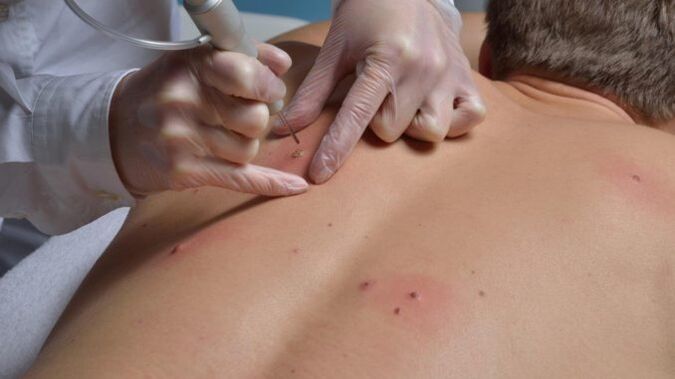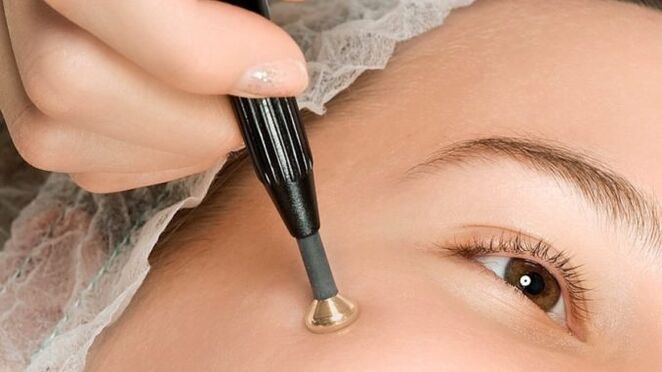PapillomaIt is a benign neoplasm that is provoked by human papillomavirus (HPV) and appears in different parts of the body: in the neck, under the arms, in the bladder, in the genitals, in the vocal cords, in the eyelids, in the mucous membranes of the mouth and nose.
Causes of occurrence
The natural cause of the formation of unpleasant growths and warts is HPV. This virus is very widespread - it occurs in about 60% of the population.
The virus spreads in the following ways:
- sexual. . . Through sexual intercourse, genital warts appear on the body.
- During birth. . . When infected during childbirth, papillomas and warts usually appear several months after birth.
- In home. . . Infection occurs at home, in public places and in transport.
- Under certainprocedures. . . For example, you can "catch" HPV during epilation or shaving.
True, despite the active spread, in 90% of cases, the body can cope with HPV independently.
Why are papillomas dangerous?

Small papillomas that appear on the human body do not always attract attention, but they can also be dangerous.
So papillomas can cause the development of terrible diseases:
- Carcinoma;
- Cervical cancer (cervical cancer);
- Cervical dysplasia;
- Oral cancers;
- Throat cancer;
- Shortness of breath and signs of asthma (especially in children);
- Impotence;
- Bowen's disease;
- Mucosal lesions.
Growths can cause psychological and aesthetic problems, but their main risk is human health problems (up to precancerous and cancerous conditions).
diagnostic

The diagnosis of HPV includes at least 7 procedures:
- Clinical examination. . . An examination specialist identifies and examines all growths in the patient's body. If anogenital warts are found, men can schedule a ureteroscopy procedure, women are scheduled to visit a gynecologist to examine the cervix.
- Colposcopy. . . Examination of the female genitals using a special device - a colposcope.
- Histological examination. . . Explore the deep areas of the Malpighian layer and the development of colocytes.
- Cytological examination. . . The classification is performed according to the PAP - stain test, which includes 5 classes. I - cytological picture is normal, V - a large number of atypical cells.
- Test Digene(screening test) This procedure allows you to quickly identify elevated virus concentrations. This test is very accurate.
- PCR printing. . . This procedure allows you to identify individual types of virus. However, the method has one drawback: 20% of PCR suppression gives a false result (since the infection is short-lived).
- PCR(orpolymerase chain reaction) Allows you to identify not only HPV, but also other sexually transmitted diseases.
Treatment
HPV requires an attentive and careful approach, and before making a decision about treatment (destruction), the patient must pass the necessary tests. Sometimes it can turn out that the patient does not need medical intervention - the papilloma may disappear over time.
Traditional treatment

Importers It is important to understand that there is no way to completely eradicate HPV. All that can be done is to eliminate the manifestations of the disease (in the form of papillomas, warts and other growths). They are the ones that cause cancers and precancerous conditions (not HPV). It happens that HPV lives in the body for up to 30 years, without appearing on the skin.
Therapy with the use of immunomodulators and antiviral drugs is rarely prescribed. Doctors prescribe such drugs in the case of highly oncogenic strains of the virus.
Formal medicine offers the following methods for removing lesions:
- Surgical removal. . . This is an extreme measure against papillomas and warts. Usually used when there are many clusters. Removal requires prior patient preparation, appropriate physician qualifications, and the use of local anesthesia.
After the operation is completed, a suture is applied to connect the tissue. The skin heals within 3-4 weeks, however, a scar / scar may remain.
- Electrocoagulation. . . Includes exposure to electric shock at the site of injury. It is necessary to "cauterize" the base of the affected area. The main advantage of this procedure is the correct closing of the vessels, practically without blood. The skin is restored within 7-10 days with minimal risk of scar formation.
- Laser removal (laser coagulation). . . Provides exposure to a focused laser beam. The procedure is performed without anesthesia and lasts only a few minutes, leaving rough crusts (they fall off quickly and leave no trace).
Laser coagulation has a minimal risk of scar formation and allows you to quickly eliminate the accumulation of warts or warts. The only disadvantage of the operation is the high cost.
- Cryodestruction (nitrogen combustion). . . To perform the procedure, you will need a drop of liquid nitrogen, which, after hitting the warts, will immediately destroy its structure. Allows you to get rid of clutter in 7-10 days.
Nitrogen cauterization is considered an effective and affordable method, however, if the area is large, several sessions may be needed. The technique is actively used in private and public clinics, aesthetics and health centers. The only downside is the risk of relapse if the specialist does not burn the growth to the end.
- Radiosurgery. . . It is performed using special equipment. The method appeared relatively recently, allows you to quickly and painlessly remove all growths. But so far, radiosurgery is unaffordable due to its high cost.
- Chemical destruction. . . During the performance, "strong" chemicals are used. substances and acids. These compounds are applied to condyloma, papilloma or warts without special equipment. This is a cheap method, but it is relatively effective.

Important!During any procedure, there is a risk of damage to adjacent tissue, which threatens the spread of the virus.
Drug treatment
Before deciding to start self-treatment, the patient should consult a specialist so that he can prescribe medications that are suitable for home use.
It is important to remember that you can not trim warts with harmless appearance yourself, as the causes of the appearance are unknown. It is even possible that this will lead to an acceleration of their growth and increase the risk of HPV degeneration in oncological tumors. When papillomas appear on the mucosal surfaces (eyes, nose or throat), the cause study and treatment should be carried out under the supervision of the attending physician.
There are the following popular ways to get rid of papillomas:
- Adhesive tape. . . Wart removal can be done using adhesive tapes purchased at the pharmacy and impregnated with a special composition. This composition has a devastating effect on papillomas for some time, then comes out with a tape. To reduce pain, the bandages are usually moistened with warm water before being removed.
- FREEZE- This is one of the most common procedures for eliminating papillomas. The use of freezing medications, as a rule, is indicated for the elimination of neoplasms with localization in the intimate area or elsewhere, and such treatment is possible without anesthesia. You can buy a special medicine yourself in a pharmacy, and the procedure requires strict adherence to the instructions. After a week of therapy, there will be no trace of papillomas.
- Pharmacy preparation with phenol, intended for the treatment of warts and papillomas. It is very effective - skin neoplasms will be eliminated after only one application, but the procedure is accompanied by pain, as a wound remains at the site of the papilloma, which requires time to heal.
- Gel with celandine extract, the effectiveness of which is confirmed by the Ministry of Health. Varies in the absence of pain during destruction.
There are various situations associated with the appearance of growths that require the destruction of neoplasms. Depending on the location of the papilloma, the urgency of its removal, and whether this is the first appearance of HPV, it is possible to use different methods of treating the papilloma.
The need to consult a specialist is also about the fact that when papillomas appear, the independent use of drugs carries the risk of developing papillomatous skin defects, as a result of which growths appear all over the body in any place. In this case, their treatment will take longer.
Folk remedies
Any self-treatment at home is often accompanied by the use of folk remedies. Along with other methods of therapy, after consulting a doctor, it is possible to use traditional medicine. They are especially useful during pregnancy and immunosuppression.
Efficacy is high in those folk remedies that increase the human body's resistance to infections. Some can be taken together with antibiotics prescribed by your doctor.
Of plant origin
To prevent the later appearance of papillomas, you can use herbal infusions every day(lemon balm, nettle, plantain leaves, horsetail, fennel, St. John's wort and others) or juice obtained from red potato tubers.
Of the herbal medicines used to remove neoplasms, it is worth noting celandine. It is permissible to use its juice, leaves or pharmacy infusion. Its regular use dries papillomas, then they just fall off.
Astrology gives its idea of how to remove papillomas- presents HPV as a viral disease in the form of skin formations, and regardless of how papillomas arise, it can only be removed when the moon fades. In this case, it is necessary to strengthen the immune system using herbal teas. Complete elimination of growths requires at least a 3-month administration course.
Non-plant origin

In addition to using herbal products, the following non-herbal products are also very effective:
- Treatment of HPV with an egg- This is one of the most effective and popular ways to eliminate papillomavirus. It consists in the fact that papillomas that have just appeared on the body are smeared with egg white, and any other layer is applied only after the previous one has dried. Within a few days, once the protein is very dry, there will simply be no more papillomas. This is a very effective and simple treatment for neoplasms in the body.
- Alcohol tincture- you need to mix 0. 1 liter of alcohol, 2 grams of boric acid, 2. 5 grams of iodine and the same amount of acetylsalicylic acid. It is forbidden to lubricate papillomas with localization on the eyelids or on the mucosa with this mixture. Instead of this recipe, you can use ammonia, or you can make balls of vinegar and flour (use of this tool has the same restrictions).
- Castor oilIt is a painless treatment for skin lesions. The effectiveness of the oil is due to the presence of acid in its composition, which destroys neoplasms.
- Kerosene oil and green nuts- used to treat papilloma virus in the form of warts, including genital ones. For this purpose, it is necessary to grind new nuts, then they are filled with kerosene in a ratio of 2 to 1. After infusing the mixture in a dark place for 3 weeks, it can be used to lubricate papillomas. This is a very effective way to eliminate any neoplasms.
- Uthull molle. . . You should pour apple cider vinegar on a clean towel or cotton swab, and then moisten the papilloma three times a day. After a few days, the growth will change color. The duration of the course is several weeks, after which the neoplasm will disappear. To make this procedure safer, it is recommended to dilute the vinegar with a little water before treating the affected area.
Even proponents of conservative treatment acknowledge the use of non-drug drugs, which completely oppose the possibility of self-medication. In fact, it is a very controversial question whether it is possible to get rid of HPV using exclusively traditional medicine.
Non-traditional treatment and medicine can be successful, but only in the right combination and with the recommendation of a specialist.














































































